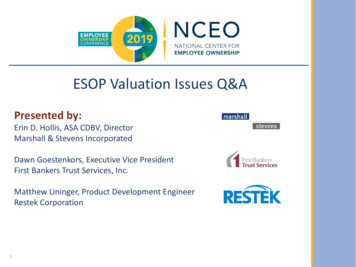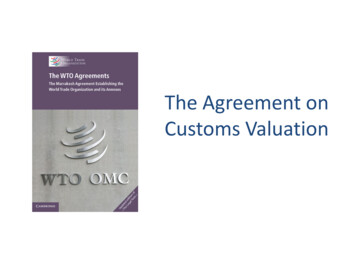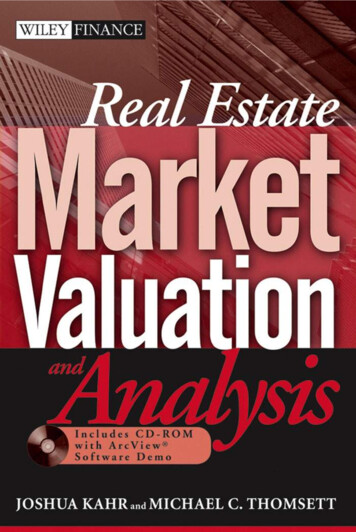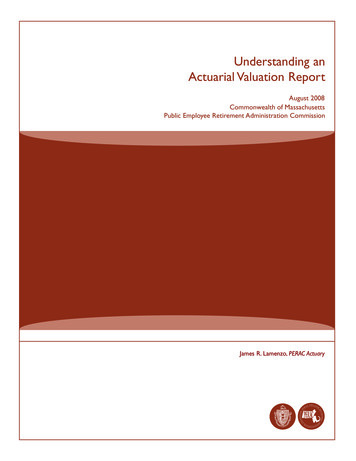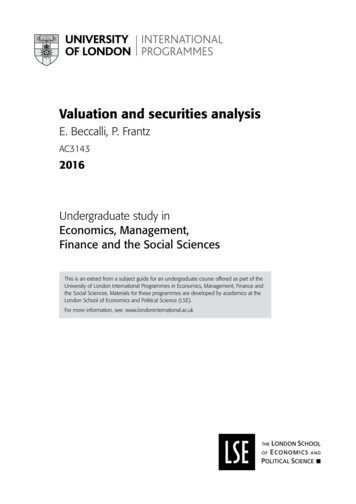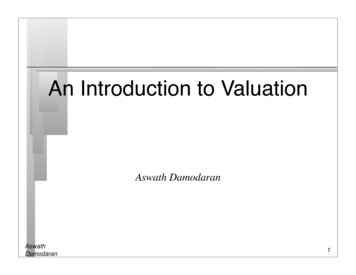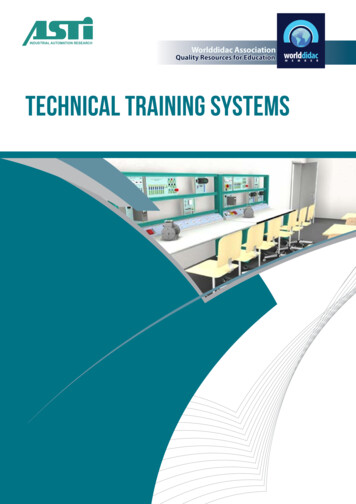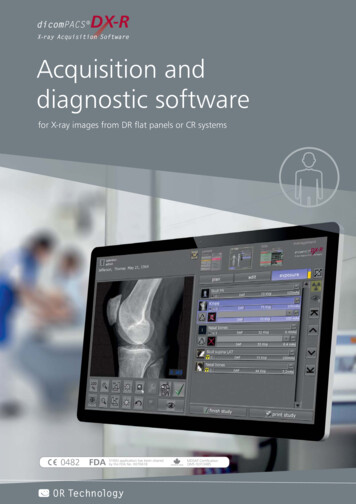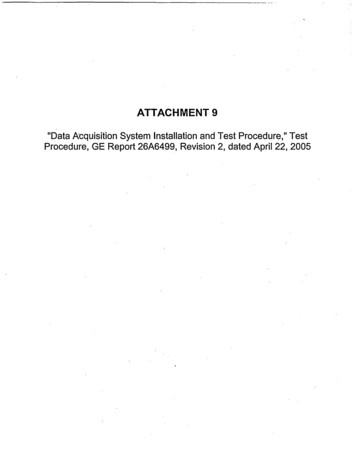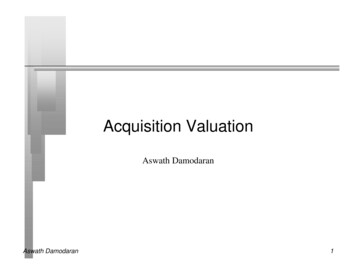
Transcription
Acquisition ValuationAswath DamodaranAswath Damodaran1
Issues in Acquisition ValuationnAcquisition valuations are complex, because the valuation ofteninvolved issues like synergy and control, which go beyond just valuinga target firm. It is important on the right sequence, including When should you consider synergy? Where does the method of payment enter the process.nCan synergy be valued, and if so, how?nWhat is the value of control? How can you estimate the value?Aswath Damodaran2
Steps involved in an Acquisition ValuationnnnnnStep 1: Establish a motive for the acquisitionStep 2: Choose a targetStep 3: Value the target with the acquisition motive built in.Step 4: Decide on the mode of payment - cash or stock, and if cash,arrange for financing - debt or equity.Step 5: Choose the accounting method for the merger/acquisition purchase or pooling.Aswath Damodaran3
Step 1: Motives behind acquisitions(1) Simplest rationale is undervaluation, i.e., that firms that areundervalued by financial markets, relative to true value, will betargeted for acquisition by those who recognize this anomaly.(2) A more controversial reason is diversification, with the intent ofstabilizing earnings and reducing risk.(3) Synergy refers to the potential additional value from combining twofirms, either from operational or financial sources. Operating Synergy can come from higher growth or lower costs Financial Synergy can come from tax savings, increased debt capacity orcash slack.(4) Poorly managed firms are taken over and restructured by the newowners, who lay claim to the additional value.(5) Managerial self-interest and hubris are the primary, though unstated,reasons for many takeovers.Aswath Damodaran4
Step 2: Choose a target firm for the acquisitionIf motive isUndervaluationDiversificationTarget firmtrades at a price below the estimated valueis in a business which is different from the acquiring firm’sbusinessOperating Synergy have the characteristics that create the operating synergyCost Savings: in same business to create economies of scale.Higher growth: should have potential for higher growth.Financial Synergy Tax Savings: provides a tax benefit to acquirerDebt Capacity: is unable to borrow money or pay high ratesCash slack: has great projects/ no fundsControlbadly managed firm whose stock has underperformed themarket.Manager’s Interests has characteristics that best meet CEO’s ego and powerneeds.Aswath Damodaran5
Step 3: Value Target Firm with motive built inIf motive isUndervaluationDiversificationOperating SynergyTarget firmValue target firm as stand-alone entity: No extra premiumValue target firm as stand-alone entity: No extra premiumValue the firms independently.Value the combined firm with the operating synergySynergy is the difference between the latter and formerTarget Firm Value Independent Value SynergyFinancial Synergy Tax Benefits: Value of Target Firm PV of Tax BenefitsDebt Capacity: Value of Target Firm Increase in Valuefrom DebtCash Slack: Value of Target Firm NPV of Projects/ TargetControlValue of Target Firm run optimallyManager’s Interest Value of Target Firm: No additional premiumAswath Damodaran6
The Valuation ProcessVALUING AN ACQUISITIONComponentAswath DamodaranValuation GuidelinesSynergyValue the combined firm with synergy built in. This may includea. a higher growth rate in revenues: growth synergyb. higher margins, because of economies of scalec. lower taxes, because of tax benefits: tax synergyd. lower cost of debt: financing synergye. higher debt ratio because of lower risk: debt capacitySubtract the value of the target firm (with control premium) value of the bidding firm (pre-acquisition). This is the value ofthe synergy.ControlPremiumValue the company as if optimally managed. Thiswill usually mean that investment, financing anddividend policy will be altered:Investment Policy: Higher returns on projects anddivesting unproductive projects.Financing Policy: Move to a better financingstructure; eg. optimal capital structureDividend Policy: Return unused cashPractically,1. Look at industry averages for optimal (if lazy)2. Do a full-fledged corporate financial analysisStatus QuoValuationValue the company as is, with existing inputsfor investment, financing and dividend policy.Should you pay?Which firm isindispensable for thesynergy?If it is the target, youshould be willing topay up to thesynergy.If it is the bidder, youshould not.If motive is control orin a stand-alonevaluation, this is themaximium you shouldpay.If motive isundervaluation, this isthe maximum youshould pay.7
Valuing NCR for AT & TVALUING NCR for AT & TComponentAswath DamodaranValuation GuidelinesSynergyValue the combined firm with synergy built in. This may includea. a higher growth rate in revenues: growth synergyb. higher margins, because of economies of scalec. lower taxes, because of tax benefits: tax synergyd. lower cost of debt: financing synergye. higher debt ratio because of lower risk: debt capacitySubtract the value of the target firm (with control premium) value of the bidding firm (pre-acquisition). This is the value ofthe synergy.ControlPremiumValue the company as if optimally managed. Thiswill usually mean that investment, financing anddividend policy will be altered:Investment Policy: Higher returns on projects anddivesting unproductive projects.Financing Policy: Move to a better financingstructure; eg. optimal capital structureDividend Policy: Return unused cashPractically,1. Look at industry averages for optimal (if lazy)2. Do a full-fledged corporate financial analysisStatus QuoValuationValue the company as is, with existing inputsfor investment, financing and dividend policy.Value 11,278 million- 6,723 million 4,552 million 6,723 million 5,949 million 774 million 5,949 million8
Step 4: Decide on payment mechanism: Cashversus StockllllnGenerally speaking, firms which believe that their stock is undervalued will not use stock to do acquisitions.Conversely, firms which believe that their stock is over or correctlyvalued will use stock to do acquisitions.Not surprisingly, the premium paid is larger when an acquisition isfinanced with stock rather than cash.There might be an accounting rationale for using stock as opposed tocash. You are allowed to use pooling instead of purchase.There might also be a tax rationale for using stock. Cash acquisitionscreate tax liabilities to the selling firm’s stockholders.Aswath Damodaran9
The Exchange Ratio in a Stock for StockExchangelllCorrect Exchange Ratio to use in a Valuation Value per Share ofBidding Firm / Value per Share of Target Firm (with control premiumand target-controlled synergies)If the exchange ratio is set too high, there will be a transfer of wealthfrom the bidding firm’s stockholders to the target firm’sstockholders.If the exchange ratio is set too low, there will be transfer of wealthfrom the target firm to the bidding firm’s stockholders.Aswath Damodaran10
Step 5: Choose an accounting method for themergernPurchase Method:– The acquiring firm records the assets and liabilities of the acquired firm atmarket value, with goodwill capturing the difference between marketvalue and the value of the assets acquired. This goodwill will then be amortized , though the amortization is not taxdeductible. If a firm pays cash on an acquisition, it has to use the purchasemethod to record the transaction.nPooling of Interests:– The book values of the assets and liabilities of the merging firms areadded to arrive at values for the combined firm. Since the market value ofthe transaction is not recognized, no goodwill is created or amortized.– This approach is allowed only if the acquiring firm exchanges its commonstock for common stock of the acquired firm.– Since earnings are not affected by the amortization of goodwill, thereported earnings per share under this approach will be greater than thereported earnings per share in the purchase approach.Aswath Damodaran11
The Value of ControlnThe value of control should be inversely proportional to theperceived quality of that management and its capacity to maximizefirm value.nValue of control will be much greater for a poorly managed firmthat operates at below optimum capacity than it is for a well managedfirm.nValue of Control Value of firm, with restructuring - Value of firm,without restructuringnNegligible or firms which are operating at or close to their optimalvalueAswath Damodaran12
Empirical Evidence on the Value of ControlTarget Characteristics - Hostile vs. Friendly TakeoversTarget ROE Industry ROETarget 5-yr stockreturns - MarketReturns% of Stock heldby insiders20.00%15.00%10.00%5.00%0.00%-5.00%Hostile TakeoversAswath DamodaranFriendly Takeovers13
After the hostile takeover.nnnnMany of the hostile takeovers were followed by an increase inleverage, which resulted in a downgrading of the debt. The leveragewas quickly reduced, however, with proceeds from sale of assets.There was no significant change in the amount of capitalinvestment in these firms, but investment was more focused on corebusiness.Almost 60% of the takeovers were followed by significantdivestitures, where half or more of the firm was divested. Theoverwhelming majority of the divestitures were of units which were inbusiness areas unrelated to the company's core business, i.e., theyconstituted reversal of earlier corporate diversification.There were significant management changes in 17 of the 19 hostiletakeovers, with the entire corporate management team replaced in 7 ofthe takeovers.Aswath Damodaran14
Stand Alone Valuation: Digital - Status QuonDigital had earning before interest and taxes of 391.38 million in1997, which translated into a A pre-tax operating margin of 3% on its revenues of 13,046 million An after-tax return on capital of 8.51%nBased upon its beta of 1.15, an after-tax cost of borrowing of 5% and adebt ratio of approximately 10%, the cost of capital for Digital in 1997was Cost of Equity 6% 1.15 (5.5%) 12.33% Cost of Capital 12.33% (.9) 5% (.1) 11.59%nnDigital had capital expenditures of 475 million, depreciation of 461million and working capital was 15% of revenues.Operating income, net cap ex and revenues are expected to grow 6% ayear for the next 5 years, and 5% thereafter.Aswath Damodaran15
Digital: Status Quo ValuationYearFCFFTerminal ValuePV1 133.26 119.422 141.25 113.433 149.73 107.754 158.71 102.355 168.24 2,717.35 1,667.47Terminal Year 156.25Firm Value 2,110.41n The capital expenditures are assumed to be 110% of revenues in stablegrowth; working capital remains 15%;n Debt ratio remains at 10%, but after-tax cost of debt drops to 4%. Betadeclines to 1.Aswath Damodaran16
Digital: Change in ControlnDigital will raise its debt ratio to 20%. The beta will increase, but thecost of capital will decrease. nnnNew Beta 1.25 (Unlevered Beta 1.07; Debt/Equity Ratio 25%)Cost of Equity 6% 1.25 (5.5%) 12.88%New After-tax Cost of Debt 5.25%Cost of Capital 12.88% (0.8) 5.25% (0.2) 11.35%Digital will raise its return on capital to 11.35%, which is its cost ofcapital. (Pre-tax Operating margin will go up to 4%)The reinvestment rate remains unchanged, but the increase in thereturn on capital will increase the expected growth rate in the next 5years to 10%.After year 5, the beta will drop to 1, and the after-tax cost of debt willdecline to 4%.Aswath Damodaran17
Digital Valuation: Change in ControlYearFCFFTerminal Value1 156.292 171.913 189.114 208.025 228.82 6,584.62Terminal Year 329.23Value of the Firm: with Control ChangeValue of the Firm: Status QuoValue of ControlAswath DamodaranPV 140.36 138.65 136.97 135.31 3,980.29 4,531 million 2,110 million 2,421 million18
Valuing SynergynThe key to the existence of synergy is that the target firm controls aspecialized resource that becomes more valuable if combined withthe bidding firm's resources. The specialized resource will varydepending upon the merger: In horizontal mergers: economies of scale, which reduce costs, or fromincreased market power, which increases profit margins and sales.(Examples: Bank of America and Security Pacific, Chase and Chemical) In vertical integration: Primary source of synergy here comes fromcontrolling the chain of production much more completely. In functional integration: When a firm with strengths in one functionalarea acquires another firm with strengths in a different functional area,the potential synergy gains arise from exploiting the strengths in theseareas.Aswath Damodaran19
Valuing operating synergy(a) What form is the synergy expected to take? Will it reduce costs as apercentage of sales and increase profit margins (as is the case whenthere are economies of scale)? Will it increase future growth (as isthe case when there is increased market power)? )(b) When can the synergy be reasonably expected to start affectingcashflows? (Will the gains from synergy show up instantaneously afterthe takeover? If it will take time, when can the gains be expected tostart showing up? )Aswath Damodaran20
A procedure for valuing synergy(1) the firms involved in the merger are valued independently, bydiscounting expected cash flows to each firm at the weighted averagecost of capital for that firm.(2) the value of the combined firm, with no synergy, is obtained byadding the values obtained for each firm in the first step.(3) The effects of synergy are built into expected growth rates andcashflows, and the combined firm is re-valued with synergy.Value of Synergy Value of the combined firm, with synergy - Value ofthe combined firm, without synergyAswath Damodaran21
Synergy Effects in Valuation InputsIf synergy isValuation Inputs that will be affected areEconomies of Scale Operating Margin of combined firm will be greaterthan the revenue-weighted operating margin ofindividual firms.Growth SynergyMore projects:Higher Reinvestment Rate (Retention)Better projects: Higher Return on Capital (ROE)Longer Growth PeriodAgain, these inputs will be estimated for thecombined firm.Aswath Damodaran22
Valuing Synergy: Compaq and DigitalnIn 1997, Compaq acquired Digital for 30 per share 0.945 Compaqshares for every Digital share. ( 53-60 per share) The acquisition wasmotivated by the belief that the combined firm would be able to findinvestment opportunities and compete better than the firmsindividually could.Aswath Damodaran23
Background DataCurrent EBITCurrent RevenuesCapital Expenditures - DepreciationExpected growth rate -next 5 yearsExpected growth rate after year 5Debt /(Debt Equity)After-tax cost of debtBeta for equity - next 5 yearsBeta for equity - after year 5Working Capital/RevenuesTax rate is 36% for both companiesAswath DamodaranCompaq 2,987 million 25,484 mil 184 million10%5%Digital: Opt Mgd 522 million 13,046 mil 14 (offset)10%5%10%5%1.251.0015%20%5.25%1.251.015%24
Valuing CompaqYearFCFFTerminal Value PV1 1,518.19 1,354.472 1,670.01 1,329.243 1,837.01 1,304.494 2,020.71 1,280.195 2,222.78 56,654.81 33,278.53Terminal Year 2,832.74 38,546.91n Value of Compaq 38,547 millionn After year 5, capital expenditures will be 110% of depreciation.Aswath Damodaran25
Combined Firm ValuationnThe Combined firm will have some economies of scale, allowing it toincrease its current after-tax operating margin slightly. The dollarsavings will be approximately 100 million. Current Operating Margin (2987 522)/(25484 13046) 9.11% New Operating Margin (2987 522 100)/(25484 13046) 9.36%nnThe combined firm will also have a slightly higher growth rate of10.50% over the next 5 years, because of operating synergies.The beta of the combined firm is computed in two steps: Aswath DamodaranDigital’s Unlevered Beta 1.07; Compaq’s Unlevered Beta 1.17Digital’s Firm Value 4.5; Compaq’s Firm Value 38.6Unlevered Beta 1.07 * (4.5/43.1) 1.17 (38.6/43.1) 1.16Combined Firm’s Debt/Equity Ratio 13.64%New Levered Beta 1.16 (1 (1-0.36)(.1364)) 1.26Cost of Capital 12.93% (.88) 5% (.12) 11.98%26
Combined Firm ValuationYearFCFF1 1,726.652 1,907.953 2,108.284 2,329.655 2,574.26Terminal Year 3,345.38Value of Combined FirmAswath DamodaranTerminal Value PV 1,541.95 1,521.59 1,501.50 1,481.68 66,907.52 39,463.87 45,51127
The Value of SynergynnnValue of Combined Firm wit SynergyValue of Compaq Value of Digital 38,547 4532Total Value of SynergyAswath Damodaran 45,511 million 44,079 million 1,432 million28
Digital: Valuation BlocksValue of Firm - Status Quo Value of ControlValue of Firm - Change of Control Value of SynergyTotal Value of Digital with SynergyAswath Damodaran 2,110 million 2,521 million 4,531 million 1,432 million 5,963 million29
Estimating Offer Prices and Exchange RatiosnThere are 146.789 million Digital shares outstanding, and Digital had 1,006 million in debt outstanding. Estimate that maximum price youwould be willing to offer on this deal.nAssume that Compaq wanted to do an exchange offer, where it wouldexchange its shares for Digital shares. If Compaq stock is trading at 27 per share, what would be the exchange ratio?Aswath Damodaran30
Evaluating Compaq’s OfferValue of Digital with Synergy 5,963 mil- Value of Cash paid in deal 30 * 146.789 mil shrs 4,403 mil- Digitial’s Outstanding Debt (assumed by Compaq) 1,006 milRemaining Value 554 mil/ number of Shares outstanding146.789 Remaining Value per Share 3.77Compaq’s price per share at time of Exchange Offer 27Appropriate Exchange Ratio 3.77/27 0.14 Compaq shares for everyDigital shareActual Exchange Ratio 0.945 Compaq shares/Digital ShareAswath Damodaran31
Citicorp Travelers ?Net IncomeBV of EquityROEDividendsPayout RatioRetention RatioExpected growthGrowth PeriodBetaRisk PremiumMV of Equity (bil)Cost of EquityBeta - stableGrowth-stablePayout-stableDDMAswath DamodaranDDM/shareCiticorpTravelersCitigroup 3,591 20,72217.33% 65.38% 70,743 3,104 20,73614.97% .92% 53,464 6,695 41,45816.15% .00%62.85% 124,009155.8446.3832
The Right Exchange RationBased upon these numbers, what exchange ratio would you agree to asa Citicorp stockholder?nThe actual exchange ratio was 2.5 shares of Travelers for every share oCiticorp. As a Citicorp stockholder, do you think that this is areasonable exchange ratio?Aswath Damodaran33
The Value of SynergyIncrease in Value of Equity as ROEIncrease30000Increase in EquityValue2500020000150001000050000Increase by1%Increase by 2%Increase by 3%Change in ROE of combined firmAswath Damodaran34
Financial SynergynSources of Financial Synergy Diversification: Acquiring another firm as a way of reducing risk cannotcreate wealth for two publicly traded firms, with diversified stockholders,but it could create wealth for private firms or closely held publicly tradedfirms. Cash Slack: When a firm with significant excess cash acquires a firm,with great projects but insufficient capital, the combination can createvalue. Tax Benefits: The tax paid by two firms combined together may be lowerthan the taxes paid by them as individual firms. Debt Capacity: By combining two firms, each of which has little or nocapacity to carry debt, it is possible to create a firm that may have thecapacity to borrow money and create value.Aswath Damodaran35
I. Diversification: No Value Creation?nnA takeover, motivated only by diversification considerations, has noeffect on the combined value of the two firms involved in the takeover.The value of the combined firms will always be the sum of the valuesof the independent firms.In the case of private firms or closely held firms, where the ownersmay not be diversified personally, there might be a potential value gainfrom diversification.Aswath Damodaran36
II. Cash SlacknnnManagers may reject profitable investment opportunities if theyhave to raise new capital to finance them.It may therefore make sense for a company with excess cash and noinvestment opportunities to take over a cash-poor firm with goodinvestment opportunities, or vice versa.The additional value of combining these two firms lies in the presentvalue of the projects that would not have been taken if they hadstayed apart, but can now be taken because of the availability of cash.Aswath Damodaran37
Valuing Cash SlacklllAssume that Netscape has a severe capital rationing problem, thatresults in approximately 500 million of investments, with acumulative net present value of 100 million, being rejected.IBM has far more cash than promising projects, and has accumulated 4 billion in cash that it is trying to invest. It is under pressure to returnthe cash to the owners.If IBM takes over Netscape Inc, it can be argued that the value of thecombined firm will increase by the synergy benefit of 100 million,which is the net present value of the projects possessed by the latterthat can now be taken with the excess cash from the former.Aswath Damodaran38
III. Tax Benefits(1) If one of the firms has tax deductions that it cannot use because it islosing money, while the other firm has income on which it payssignificant taxes, the combining of the two firms can lead to taxbenefits that can be shared by the two firms. The value of this synergyis the present value of the tax savings that accrue because of thismerger.(2) The assets of the firm being taken over can be written up to reflectnew market value, in some forms of mergers, leading to higher taxsavings from depreciation in future years.Aswath Damodaran39
Valuing Tax Benefits: Tax LossesnAssume that you are Best Buys, the electronics retailer, and that youwould like to enter the hardware component of the market. You havebeen approached by investment bankers for Zenith, which while still arecognized brand name, is on its last legs financially. The firm has netoperating losses of 2 billion. If your tax rate is 36%, estimate the taxbenefits from this acquisition.nIf Best Buys had only 500 million in taxable income, how would youcompute the tax benefits?nIf the market value of Zenith is 800 million, would you pay this taxbenefit as a premium on the market value?Aswath Damodaran40
Valuing Tax Benefits: Asset Write UpnOne of the earliest leveraged buyouts was done on Congoleum Inc., adiversified firm in ship building, flooring and automotive accessories,in 1979 by the firm's own management. After the takeover, estimated to cost 400 million, the firm would beallowed to write up its assets to reflect their new market values, and claimdepreciation on the new values. The estimated change in depreciation and the present value effect of thisdepreciation, discounted at the firm's cost of capital of 14.5% is shownbelow:Aswath Damodaran41
Congoleum’s Tax BenefitsYearDeprec'nbefore1980 8.001981 8.801982 9.681983 10.651984 11.711985 12.651986 13.661987 14.751988 15.941989 17.211980-89 123.05Aswath DamodaranDeprec'nafter 35.51 36.26 37.07 37.95 21.23 17.50 16.00 14.75 15.94 17.21 249.42Change inDeprec'n 27.51 27.46 27.39 27.30 9.52 4.85 2.34 0.00 0.00 0.00 126.37Tax Savings PV 13.20 13.18 13.15 13.10 4.57 2.33 1.12 0.00 0.00 0.00 60.66 11.53 10.05 8.76 7.62 2.32 1.03 0.43 0.00 0.00 0.00 41.7642
IV. Debt CapacitynnDiversification will lead to an increase in debt capacity and anincrease in the value of the firm.Has to be weighed against the immediate transfer of wealth that occursto existing bondholders in both firms from the stockholders.Aswath Damodaran43
Valuing Debt CapacitynnWhen two firms in different businesses merge, the combined firm willhave less variable earnings, and may be able to borrow more (have ahigher debt ratio) than the individual firms.In the following example, we will combine two firms, with optimaldebt ratios of 30% each, and end up with a firm with an optimal debtratio of 40%.Aswath Damodaran44
Effect on Costs of Capital of Added debtDebt (%)Cost of debtEquity(%)Cost of equityWACC - Year 1WACC- Year 2WACC- Year 3WACC-Year 4WACC-Year 5WACC-after year 5Aswath DamodaranFirm AFirm %10.37%AB -NoNew %10.45%AB - 10.45%9.76%45
Effect on Value of Added DebtFirm AFirm BAB -No new AB - AddedDebtDebtFCFF in year 1 120.00 220.00 340.00 340.00FCFF in year 2 144.00 242.00 386.00 386.00FCFF in year 3 172.80 266.20 439.00 439.00FCFF in year 4 207.36 292.82 500.18 500.18FCFF in year 5 248.83 322.10 570.93 570.93Terminal Value 5,796.97 7,813.00 13,609.97 16,101.22Present Value 4,020.91 5,760.47 9,781.38 11,429.35n The value of the firm, as a consequence of the added debt, willincrease from 9,781.38 million to 11,429.35 million.Aswath Damodaran46
Empirical Evidence on SynergynnnIf synergy is perceived to exist in a takeover, the value of thecombined firm should be greater than the sum of the values of thebidding and target firms, operating independently.V(AB) V(A) V(B)Bradley, Desai and Kim (1988) use a sample of 236 inter-firm tenderoffers between 1963 and 1984 and report that the combined value ofthe target and bidder firms increases 7.48% ( 117 million in 1984dollars), on average, on the announcement of the merger.Operating synergy was the primary motive in one-third of hostiletakeovers. (Bhide)Aswath Damodaran47
Operational Evidence on Synergy A stronger test of synergy is to evaluate whether merged firmsimprove their performance (profitability and growth), relative totheir competitors, after takeovers. McKinsey and Co. examined 58 acquisition programs between 1972 and1983 for evidence on two questions Did the return on the amount invested in the acquisitions exceed the cost ofcapital? Did the acquisitions help the parent companies outperform the competition? They concluded that 28 of the 58 programs failed both tests, and 6failed at least one test. Large number of acquisitions that are reversed within fairly shorttime periods. About 20.2% of the acquisitions made between 1982and 1986 were divested by 1988. In studies that have trackedacquisitions for longer time periods (ten years or more) the divestiturerate of acquisitions rises to almost 50%.Aswath Damodaran48
Who gets the benefits of synergy?nnThe sharing of the benefits of synergy among the two players willdepend in large part on whether the bidding firm's contribution to thecreation of the synergy is unique or easily replaced. If it can beeasily replaced, the bulk of the synergy benefits will accrue to thetarget firm. It is unique, the sharing of benefits will be much moreequitable.Bradley, Desai and Kim (1988) conclude that the benefits of synergyaccrue primarily to the target firms when there are multiple biddersinvolved in the takeover. They estimate that the market-adjusted stockreturns around the announcement of the takeover for the successfulbidder to be 2%, in single bidder takeovers, and -1.33%, in contestedtakeovers.Aswath Damodaran49
Aswath Damodaran 3 Steps involved in an Acquisition Valuation n Step 1 : Establish a motive for the acquisition n Step 2: Choose a target n Step 3: Value the target with the acquisition motive built in. n Step 4 : Decide on the mode of payment - cash or stock, and if cash, arrange for financing - debt or equity. n Step 5:
